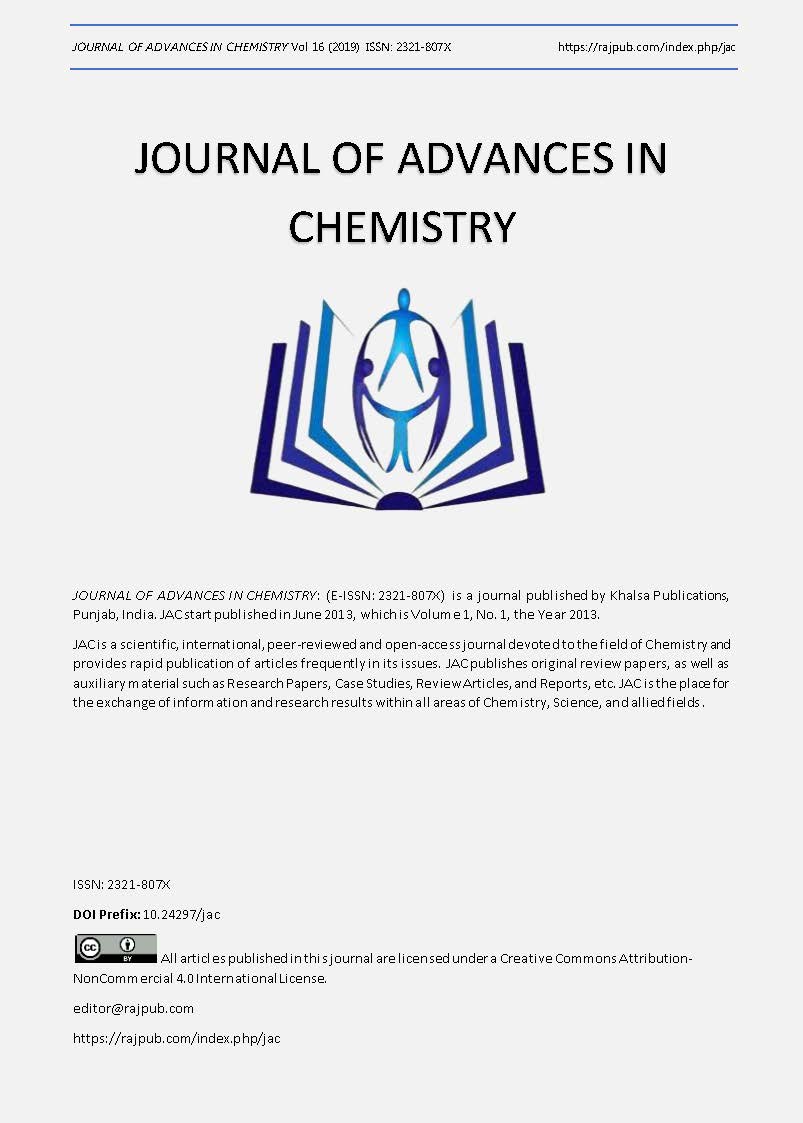Chemical Speciation and Mobility of Heavy Metals in Soils Around Nasara Sack and Packaging Company Akwanga, Nigeria
DOI:
https://doi.org/10.24297/jac.v16i0.8434Keywords:
Soil, Heavy Metals, Mobility Factor, Risk AssessmentAbstract
This study quantified and assessed the mobility of iron, nickel, cobalt and lead in soils around a sack and packaging company using indices such as mobility factor and risk assessment code. The results evaluating the mobility factor of heavy metals in soils around the sack and packaging company reveal that all the metals determined exceed the minimum limit of 10% mobility factor and are mobile with the mobility factor being in the order of: Ni > Pb > Co > Fe in the test soil. The risk assessment of heavy metals in the area based on risk assessment code ranged from low risk to medium risk (1-30%) where the risk level of the heavy metals is in the order: Co > Ni > Pb > Fe in the test soil.
Downloads
References
Galdamas, A., Mendoza, A., Orueta, M., deSoto Garcia, I.S., Sanchez, M., Virto, I., Vilas, J.L. 2017. Development of new remediation technologies for contaminated soils based on the application of zero-valent iron nanoparticles and bioremediation with compost. Resource-Efficient Technologies 3: 166-176.
Cottenie, A., and Verloo, M. 1984. Analytical diagnosis of soil pollution with heavy metals. Fresenius Journal of Analytical Chemistry, 317(3-4): 389–393.
Salim, I., Miller, C., and Howard, J. 1993. Combined sequential extraction-adsorption isotherm analysis of the heavy metal retention characteristics of a Michigan landfill bottom liner, in Proceedings of Joint CSCE-ASCE National Conference on Environmental Engineering, 1: 821–828, Montreal, Canada
Kabata-Pendias A. and Pendias, H. 2001. Trace elements in soils and plants, CRC Press, Boca Raton, Florida, USA, 3rd edition.
Hirner, A.V., 1992.Trace element speciation in soils and sediments using sequential chemical extraction methods,” International Journal of Environmental Analytical Chemistry, 46(1–3): 77–85.
Motsara, M.R., and Roy, R.N., 2008. Guide to laboratory establishment for plant nutrient analysis. FAO Fertilizer and Plant Nutrition Bulletin, 19: 17-22.
Yerima, E.A., Donatus, R.B., Opara, I.J., Egah, G.O. and Ani, J.D. 2018 Assessment of Heavy Metals Level of Soils Around Sacks and Packaging Company, Akwanga Nasarawa State, Nigeria. J Environ Anal Chem 5: 251. DOI: 10.4172/2380-2391.1000251
Walkley, A. and Black, I. A., 1934. An Examination of the Degtjareff Method for Determining Organic Carbon in Soils: Effect of Variations in Digestion Conditions and Inorganic Soil Constituents. Soil Science, 63, 251 – 263.
Souza, D.M., Morais, P.A.O., Matsushige, I. and Rosa, L.A. 2016. Development of Alternative Methods for Determining Soil Organic Matter. Rev Bras Cienc Solo., 40: 1-17
Kjeldahl, J. Z. 1883. A new method for the determination of nitrogen in organic bodies. Analytical Chemistry, 22: 366.
Bray, R.H., and Kurtz, L.T. (1945). Determination of total, organic and available forms of phosphorus in soils. Soil Sci., 59: 30–45.
Tessier, A., Campbell, P.G.C., and Bisson, M. (1979). Sequential extraction procedure for the speciation of particulate trace elements. Anal. Chem., 51: 844-851.
Soon, Y.K. and Abboud, S. (1990). Trace element of agricultural soils of Northwest Alberta. Canadian journal of soil sciences, 70: 277-288.
Yusuf, K.A., 2007. Sequential Extraction of Lead, Copper, Cadmium, and Zinc in Soils near Ojota Waste Site. Journal of Agronomy, 6: 331-337.
Singh KP, Mohan D, Singh VK, Malik A. (2005). Studies on distribution and fractionation of heavy metals in Gomati river sediments; a tributary of the Ganges, India. J. Hydrol. 312:14–27.
Greg, L., and Laura, L. (2012). Interpreting a Soil Test Report. Agriculture and Natural Resources Ohio State University Extension AGF-514: 1-2.
Itodo, A.U., Ubi-mago, M., and Wuana, R.A. (2018). Environmental Impact of Abandoned Asphalt Production Site on Soil, Water and Vegetables from Near Farmlands. Journal of Geoscience and Environment Protection, 6: 107-122.
Ramirez, M., Massolo, S., Frache, R., and Correa, J.A. (2005). Metal speciation and environmental impact on sandy beaches due to El Salvador copper mine, Chile, Marine Pollution Bulletin, 50 (1): 62–72.
Echevarria G, Massoura S, Sterckeman T, Becquer T, Schwartz C, Morel JL (2006). Assessment and control of the bioavailability of Ni in soils. Environ Toxicol Chem., 25:643–651.
Wade, K. M. (2017). Garden pest and nutrient inbalance. Retrieved from: http://plantprobs.net/
Downloads
Published
How to Cite
Issue
Section
License
 All articles published in Journal of Advances in Linguistics are licensed under a Creative Commons Attribution 4.0 International License.
All articles published in Journal of Advances in Linguistics are licensed under a Creative Commons Attribution 4.0 International License.




